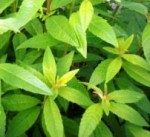 The scent of lemon is always welcome in my garden and lemon verbena is one of the most delightfully lemony. Just brush by the plant and it will release its delicate fragrance. Of course, it is tasty as well and can be used in a variety of ways in the kitchen. Try it with fish or poultry to brighten the flavor or use it in marinades, salad dressings, jams and herbal tea. It can be used in place of lemon zest in recipes, or to make sorbet, but mince the leaves finely when using in any dish because they are tough. The leaves are good in potpourris and sachets, and can give a special meaning to bouquets according to the language of flowers (responsibility, attractive to the opposite sex). Try a sprig in a finger bowl as an old fashioned touch to a formal dinner. Unfortunately, the plant is very tender and is best grown in a container in most areas of the country where it will have to winter indoors. Since it is deciduous, the leaves will drop in the fall but will return in spring; just water it sparingly as the plant will not need much water without leaves.
The scent of lemon is always welcome in my garden and lemon verbena is one of the most delightfully lemony. Just brush by the plant and it will release its delicate fragrance. Of course, it is tasty as well and can be used in a variety of ways in the kitchen. Try it with fish or poultry to brighten the flavor or use it in marinades, salad dressings, jams and herbal tea. It can be used in place of lemon zest in recipes, or to make sorbet, but mince the leaves finely when using in any dish because they are tough. The leaves are good in potpourris and sachets, and can give a special meaning to bouquets according to the language of flowers (responsibility, attractive to the opposite sex). Try a sprig in a finger bowl as an old fashioned touch to a formal dinner. Unfortunately, the plant is very tender and is best grown in a container in most areas of the country where it will have to winter indoors. Since it is deciduous, the leaves will drop in the fall but will return in spring; just water it sparingly as the plant will not need much water without leaves.
Type: Deciduous tender perennial herb.
Bloom: Tiny, tubular lavender to white flowers are borne in spikes or racemes in late summer and fall.
Foliage: Light green lanceolate, 2-4” long, ½ – 1” wide leaves borne in whorls of 3-4.
Size: In warm climates, 10-15’ H; 5’ H in cooler climates.
Light: Full sun.
Soil: Fertile, moist but well drained, light loam.
Hardiness: Zones 9-10.
Fertilizer: Apply fish emulsion regularly.
Care: Grow on pots on a hard surface so roots can not become established in soil and be damaged when the plant is moved indoors. Cut the plant back halfway in midsummer and again before the first frost; remove weak or spindly branches before bringing indoors. Harvest sprigs at any time.
Pests and Diseases: Spider mites, whiteflies.
Propagation: Cuttings.
